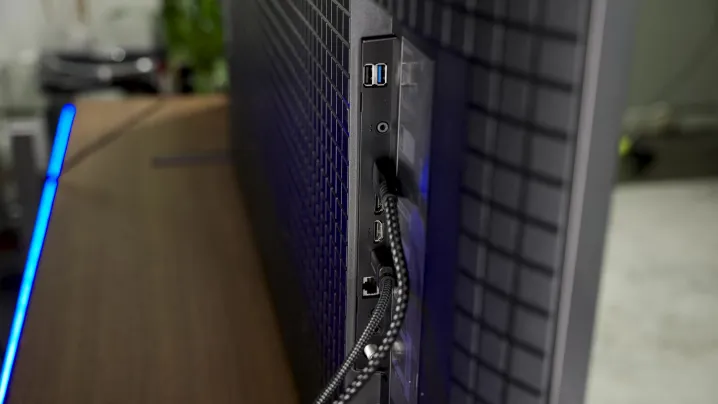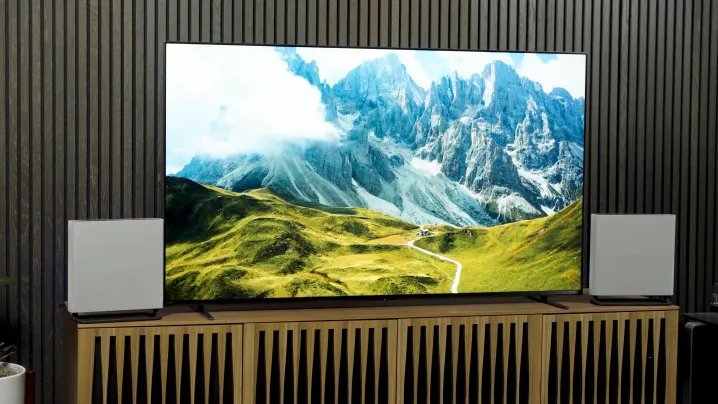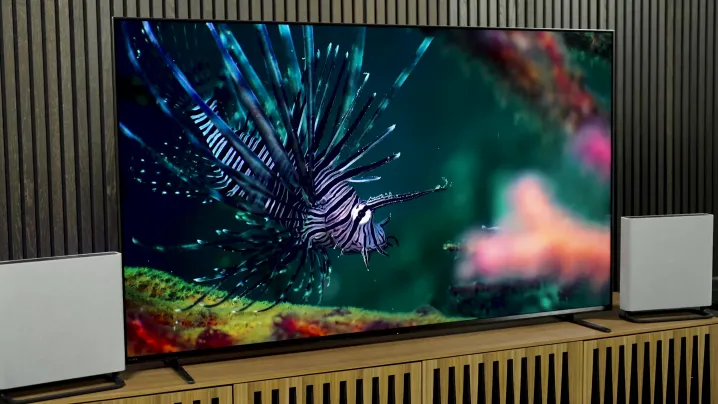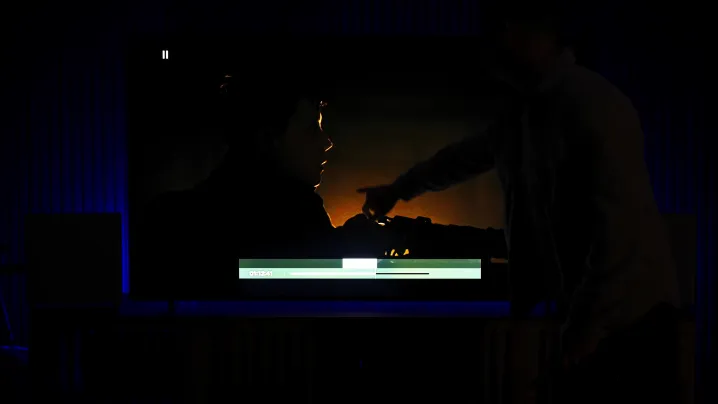Sony Bravia 7
MSRP $2,299.00
Pros
- Bright and vivid
- Excellent black levels/contrast
- Extremely accurate HDR/Color
- Top-tier motion/upscaling
- Easy to use
Cons
- Limited viewing angle
- Poor reflection handling
The Sony Bravia 7 is a popular TV. It’s a mini-LED TV that, while still fairly expensive, costs far less than the flagship Bravia 9. And because it’s a Sony TV, we can expect that it will be pretty awesome. And in many ways it is.
But it’s also a curious TV. I don’t know if I’ve ever reviewed a TV that aced so many exams and yet still had to fight for my recommendation.
In most ways, the Bravia 7 is a big upgrade over last year’s Sony X90L. And while it isn’t quite the aggressive performer that Sony’s set-up Bravia 9 is? It is indeed an awesome TV.
Yet, the number of people I’m going to recommend the Bravia 7 to is … well, relatively small.
How do we square that up? Let’s get into it.
Video review
Sony Bravia 7 specs
| Size | 55, 65, 75, 85 inches |
| Display type | Mini-LED |
| Backlight Type |
Full Array Local Dimming |
| Operating system | Google TV |
| Screen resolution | 4K |
| HDR support | HDR 10, Hybrid Log-Gamma (HLG), Dolby Vision |
| Refresh rate | 120Hz |
| Audio support | 7.1 channel linear PCM: 32/44.1/48/88.2/96/176.4/192kHz 16/20/24bits, Dolby Audio, Dolby Atmos, DTS, DTS Express, DTS-HD Master Audio, DTS-HD High Resolution Audio, DTS:X |
| Connectivity | 4 HDMI ports (2 HDMI 2.1), 1 LAN, 1 ARC, 1 RF Antenna, 1 Optical Digital Audio Output, 2 USB |
| Networking | Wi-Fi, Ethernet |
| Tuner | ATSC 3.0 |
Out of the box
Sony starts out with a big win. This TV is so easy to set up.
Not only can the feet be placed at multiple widths and at multiple heights, but when it comes to putting the feet into the TV, they just slot right in. You don’t have to screw them in. If you want enough height to accommodate the soundbar, you do have to adjust some screws in the feet. But most folks are gonna be able to get this TV out of the box, pop the feet into the bottom of the TV, and plug it in with minimal hassle and in record time.
Fit and finish
And the Bravia 7 looks and feels great, too. It has “class” written all over it.
Basic day-to-day use
Dig below the surface and you’ll find a TV that is super easy to use. Sony has created a customized UI that sits over Google TV that, at least for now, is my favorite among TV manufacturers (although, to be fair, I haven’t gotten to the new Panasonics that just landed in the U.S. so whether Sony remains my favorite, it’s easily better than the competition).
This TV is so easy to set up.
Of course, you can only spend so much time rooting around in the settings, which Sony tries to minimize by automating a lot of things. And the good news here is that this TV has run Google TV darn near flawlessly for me thus far. It looks like there was a problem getting custom picture settings to stick when the TV was in its basic mode, but that was fixed with a recent software update.

The remote — which isn’t backlit — is not rechargeable like the Bravia 9. But you will notice it looks a bit different. This isn’t a new finish, per se. That’s not paint splatter. The remote is now made with Sony’s SORPLAS recycled plastics material, which Sony now uses in a bunch of its products to lower its carbon footprint. That’s a yay, from me, for the planet.
The ins and outs
TV enthusiasts already know this, but Sony doesn’t make its own system on chip (SOC), although it does program that chip with its secret sauce. But that SOC is part of a whole board that includes the inputs and outputs. That means that you only get two HDMI 2.1 inputs, and one of those is the eARC port, which for a lot of folks will be taken up by a soundbar or A/V receiver. Sony would very much like you to occupy that port with an HDMI cable leading to its Bravia Theater Quad system (a move I whole-heartedly endorse, by the way). This isn’t going to be a problem for most folks. But for anyone with both the latest Xbox and latest PlayStation, or one of those consoles and a gaming PC they want to hook up … only one of those devices can connect to the TV for full-on 4K 120Hz gaming.

But don’t yell at Sony about this. Yell at MediaTek to make a next-gen SOC with four HDMI 2.1 inputs and a chip that is more or less the same as the Pentonic 1000 so Sony doesn’t have to rewrite all its code (again) and we don’t have to suffer the growing pains with Sony (again) just to have four HDMI 2.1 inputs.
Sound quality
For sound quality, the Bravia 7 gets a thumbs up from me. However it’s not two enthusiastic thumbs up — like I’ve been giving some of Hisense’s TVs — but one well-earned thumbs up for crystal clear sound with good balance and reasonably high fidelity. It’s a little light on bass and presence, but these days, if voices sound intelligible, it gets my nod of approval.
Like the X90L, the sound is not good enough for me to want to set up Sony’s acoustic center sync with the Bravia Theater Quad. The Theater Quad’s phantom center is very convincing, and the Bravia and TV’s speakers will only be a distraction. So skip it.
Picture setup tips
Before getting into picture quality, I’ll share an interesting experience I had when getting this TV ready for evaluation. On Sony TV’s, I instantly switch the picture mode to “professional” and make adjustments from there. This means the TV is going to be dialed in for its most accurate picture — not necessarily its most bright, but that’s easy to adjust. I’m used to seeing a dimmer picture in SDR when choosing professional mode, but in the case of the Bravia 7, even in its out-of-the-box standard picture mode, cinema mode, and professional mode, the SDR picture seemed really dim. So if you get this TV, expect to make adjustments to taste.
A step further on this: The Bravia 7 counts a Prime Video calibrated mode as well as a Netflix calibrated mode among its features. And while it’s cool that these picture modes are available, I don’t support them being turned “on” by default. Turns out, this was Amazon Prime Video’s decision — not Sony’s — and it’s a problem for Sony TV owners.
Many of you will be happiest with the local dimming setting on “high” and the peak brightness setting on “high.” You can then evaluate whether to boost the brightness level. The TV may seem dim out of the box, but don’t worry: This TV has all the brightness you need and want, and then some. You just need to do a little work for it.

Also, I got a software update while I was reviewing the Bravia 7 — one that I think also went out to the Bravia 9. The description promises to fix, among other things, “an issue where the screen brightness may increase when subtitles are shown.” So, make sure to check for an update when you set up this TV. It should be applied automatically during initial setup, but, as I like to say from time to time: trust, but verify.
Numbers for Nit Nerds
If you are a Nit Nerd, then you already know that this TV is gonna ace almost every measurement, right? It does. But, as usual, we’ll start with brightness, which is where most of the interesting results came in anyway.
I can’t recall what this TV’s default SDR brightness setting was in professional mode — it may have been 20, but by the time I got started on it, it was up at 30. Regardless, I have numbers for the brightness set at 20, 30, and 50 with all other settings at default, which means that local dimming was at medium and peak brightness was off.

At a setting of 20, SDR peak brightness on the Bravia 7 was 265 nits. At 30 it was 375 nits. At a maxed-out 50, it measured 522 nits, which is fairly bright, but far lower than I was expecting. After turning the peak brightness and local dimming to high, I reached the 1,800 nit territory — which is absolutely insane. (I like that Sony gives you a broad range of control to dial the TV in just how you need it to be.)
White balance came in excellent. It was a little hot on the red, but that is easily fixed with a couple of clicks in the 2-point white balance menu. Stock professional mode came in with a max delta E at about 2. Respect.
It was a similar story with the 20-point grayscale. Excellent performance in the pro mode. Only the brightest whites were above a delta E of 2, and only by a touch. More respect.
The Bravia 7’s picture quality is superb.
All colors in the color gamut test were under a delta E of 2. And the very challenging color-checker test? The Bravia 7 aced it, with a max delta E of 3.8 and an average of 1.8 — that is awesome for a stock picture mode.
Color saturation and luminance tests in SDR were also aced.
When it comes to HDR (and I may have already spoiled the peak brightness news), in a 10% window it was around 1,900 nits — it was testing 2,000 nits at one point. Bumping the window size up or down brought the peak brightness number down, often closer to 1,600 nits for me, and 1,300 at default settings, and full screen brightness can be as high as 700 nits.

A real-life HDR test shows peak HDR highlights are probably hanging out closer to 1,100 nits, which is enough to accurately reproduce most of the HDR content you can lay your eyes on.
The Bravia 7 follows the EOTF curve like a true champion — about as perfect as it gets. You can choose picture modes that overbrighten HDR if you want, though. But, in a professional mode, this is what you wanna see. Mad respect.
The HDR color checker is also super impressive. It is so rare to see a TV get all of these right. (Sony continues to be the standard setter for color accuracy, and I am here for it!)

DCI P3 color gamut coverage came in at 97% — a passing grade, but expected. And BT-2020 coverage came in at a delightful 80%, which is great for a mini-LED TV — although a reminder: the Hisense UX hit 83%.
One other nit-nerd specific thing. I checked the Bravia 7 for near-black chrominance overshoot, which seems to be a known issue on some other Sony TVs that use the Pentonic 1000 SOC, like the A95L and Bravia 9. There may be a little here, but I really struggled to see it.
Picture quality
Here’s what you need to know about the Bravia 7’s picture quality, starting with the good stuff and ending with two problematic things.
In short, the Bravia 7’s picture quality is superb. It’s so clean and crisp, and vibrant and accurate. The colors just look right, even without a frame of reference. (I know a Sony picture the instant I see it, and the Bravia 7 has all that swagger.) Sure, the Bravia 9 is technically better, but most folks likely wouldn’t see the difference even when it’s pointed out.

The Bravia 7’s picture quality is noticeably better than the Hisense U8 and TCL QM8. And, I would put it above the Samsung Q90D in several respects as well.
Let’s break the picture quality down:
Brightness
The Bravia 7’s brightness capabilities are stunning. By the numbers, it doesn’t measure as the brightest TV — that honor goes to the Hisense U8 and TCL QM8. But in real life, the perceived brightness of this TV is right on par with those other light cannons. It’s truly incredible — when TV is set up to do it.
Contrast
The backlight control on this TV is very good. I sometimes wish it were a little more speedy so that any visible halo following objects moving around the screen disappeared faster. But that’s when I’m looking for that kind of error. When I relax and just enjoy content and get caught up in the story? I notice none of that. And neither will most of you. Again, the Bravia 9 is technically better, but the Bravia 7, with fewer zones, beats most of its mini-LED competition for real-life viewing.

Any halo or blooming is barely visible from dead-on. However, off-axis is another story. But black levels and contrast are superb. The one caveat: slight noise in super dark blacks. They aren’t crushed, but you get a little noise and banding in really challenging dark scenes.
Color
When it comes to color, and SDR and HDR? The Bravia 7 is an A++++++++++++++. Valedictorian. Magna Cum Laude. Sony wins, period.
Motion
As for motion, Sony is the king. LG is not far behind. Panasonic, I suspect, will give Sony a run for its money, but Sony’s processing helps ensure it is the best at motion.
Upscaling
Sony’s upscaling and low bitrate content clean-up is as good as it gets. Again, LG is close. But you aren’t going to do better than Sony. Upscaling 720p is hard — and even the great Sony can only do so much — but again, nobody else does it better.

Gaming
I’m a very casual gamer. I don’t care about 144Hz. I do care about getting VRR just because I want that feature, but most of the games I play don’t offer it. I’m playing 4K/60 most of the time, and that suits me just fine.
The cons: off-angle performance and reflection handling
Now for the bad news. The off-angle performance is not good. I’ve been willing to forgive much less expensive TVs here, but this expensive Sony Bravia 7 doesn’t get that pass. Samsung is out there with some awesome off-angle viewing tech. Sony, you can do it too. Please do.
For anyone out there who wants to criticize Sony for not using an ADS Pro panel, understand that, as far as I’m aware, BOE, the top provider of ADS Pro panels — like the one you see in some Hisense 75-inch models — is only available in 75 and (I think) 85-inch sizes. So, ADS Pro and its naturally superior off-angle viewing, while still maintaining good contrast and color, is not an option for the 65-inch size. And it could be that Sony is not a fan of that panel for other quality reasons, which is why we may not see it used in the 75- and 85-inch versions of this TV.

But, an off-angle improvement filter is something I would like to see on a TV like the Bravia 7.
For now. If you have a big enough screen size of the Bravia 7 TV, it may not be a problem. But if you are serving a big room with a sectional couch using a 65-inch TV, the folks on the side seats will get a washed-out picture. Actually, you don’t have to be that far off to the side for the picture to suffer. That’s why I am so disappointed.
Also, the anti-glare, anti-reflection treatment on this TV? It has me bewildered, because I can see there is something in use here but it doesn’t seem like it is doing much. Anything that is illuminated behind you — not just direct light sources — is going to show up on the screen when viewing medium to dark scenes. This TV can get bright enough to battle back ambient light, but I can’t stand behind it as a daytime living room TV when it is a dark mirror like this. I’m pretty bummed about that.

One other annoyance. I know the professional mode is meant to act like filmmaker mode — that it is meant to be viewed in a pitch-black room and express the creator’s intent. But I feel like sometimes this TV is too dark. Dolby Vision Dark is especially trying. It seems like the average picture level is too low. My experience doesn’t square up with the measurements and it is too dim too often. I rarely settle on Dolby Vision Bright because it lifts the brightness across the board. But on this TV I have to, because Dolby Vision dark is just unwatchable for me.
Final verdict
The off-angle performance and the poor reflection handling are two big hits for a TV at this price — and it is super frustrating given that nearly every other performance point on this TV is just state-of-the-art awesome, bar-setting quality. Otherwise the Bravia 7 is so, so, so good. And just enjoyable. You don’t have to be an enthusiast or purist to see how awesome the picture is — all in a really attractive package with an easy-to-use experience built in.
But, at the end of the day, I feel like this TV belongs in dedicated entertainment spaces where light control is built in and other accommodations can be made for the reflective screen. And sadly, that makes for a pretty niche group of folks for whom this TV would be my top recommendation. The average American living room is just not the right spot for this TV, I think.
However, if you’re looking for a killer TV for your entertainment room, home theater, or game room, the Bravia 7 is superb. It’s a step up for Sony, and I’m glad they made it (well, I’m glad with 90% of it).




